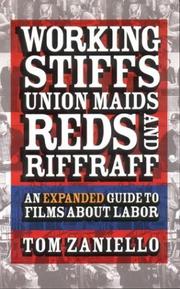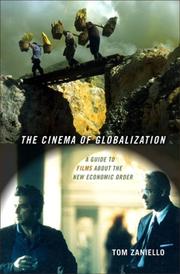| Listing 1 - 10 of 11 | << page >> |
Sort by
|
Book
ISBN: 0875463533 Publisher: Ithaca Cornell University Press
Abstract | Keywords | Export | Availability | Bookmark
 Loading...
Loading...Choose an application
- Reference Manager
- EndNote
- RefWorks (Direct export to RefWorks)

ISBN: 1501711199 9781501711190 0801440092 9780801440090 0801488516 9780801488511 Year: 2018 Publisher: Ithaca, NY : Cornell University Press,
Abstract | Keywords | Export | Availability | Bookmark
 Loading...
Loading...Choose an application
- Reference Manager
- EndNote
- RefWorks (Direct export to RefWorks)
The revised and expanded edition of Working Stiffs, Union Maids, Reds, and Riffraff offers 350 titles compared to the original edition's 150. The new book is global in scope, with examples of labor films from around the world. Viewers can turn to this comprehensive, annotated guide for films about unions or labor organizations; labor history; working-class life where an economic factor is significant; political movements if they are tied closely to organized labor; production or the struggle between labor and capital from a "top-down"-either entrepreneurial or managerial-perspective. Each entry includes a critical commentary, production data, cast list, MPAA rating (if any), suggested related films, annotated references to books and websites for further reading, and information about availability of films for rental and/or purchase. This edition addresses both historical and contemporary films and features many more documentaries and hard-to-find information about agitprop and union-financed films.Working Stiffs, Union Maids, Reds, and Riffraff: An Expanded Guide to Films about Labor features fifty-eight production stills and frame enlargements. It also includes a greatly expanded Thematic Index of Films. Two new sections will help the reader discover labor films in chronological order or by nationality or affiliation with certain cinematic movements. To read Tom Zaniello's blog on the cinema of labor and globalization, featuring even more reviews, visit http://tzaniello.wordpress.com.Praise for the earlier edition-"Zaniello has created a useful and far-reaching guide with abundant information.... These are the sorts of films that prove what James Agee wrote in these pages nearly fifty years ago: 'The only movies whose temper could possibly be described as heroic, or tragic, or both, have been made by leftists.'"-The Nation"Zaniello has done a monumental job identifying the films that should be included in this genre.... Working Stiffs, Union Maids, Reds, and Riffraff is sorely needed and long overdue."-Cineaste"An engaging and opinionated book.... Even though mining, trucking, Jimmy Hoffa, and class warfare are the book's major themes, what holds the project together is Zaniello's sense of fun and wit. [Zaniello is] a better writer than most major film critics."-Village Voice Literary Supplement

ISBN: 1501711342 9781501711343 9780801444920 0801444926 9780801473067 0801473063 Year: 2018 Publisher: Ithaca, NY
Abstract | Keywords | Export | Availability | Bookmark
 Loading...
Loading...Choose an application
- Reference Manager
- EndNote
- RefWorks (Direct export to RefWorks)
Tom Zaniello's fascinating new guide to films about globalization-its origins, its relationship with colonialism, neocolonialism, the growth of migratory labor, and movements to counter or protest its adverse effects-offers readers and viewers the opportunity to both discover new films and see well-known works in a new way. From Afro@Digital to Zoolander, Zaniello discusses 201 films, including features such as The Constant Gardener, Dirty Pretty Things, and Syriana; documentaries and other nonfiction films such as Blue Vinyl, Darwin's Nightmare, and Wal-Mart: The High Cost of Low Price; online films; and television productions. Zaniello casts a wide net to provide cinematic representations of globalization from all angles:-films about global labor and labor unions affected by globalization;-films about global capital and multinational corporations;-films about the transnational organizations (WB, IMF, WTO) most closely identified with globalization and global capital;-films about labor history and the daily life of working-class people as they relate to the development of globalization;-films about the environment directly related to changes in labor or capital; and-films about changes in both the workplace and the corporate office in the era of multinational corporations. Each entry in The Cinema of Globalization offers a summary of the main issues in the film and their relationship to globalization, sometimes a reference to the film's place in a director's work or tradition of cinema, and an often-opinionated assessment of the film's strengths and weaknesses. Like the best film guides, this book is an addictive reading experience full of ideas for future viewing. At the same time, it serves as an inviting and accessible introduction to a difficult topic-the central themes and aspects of globalization.To read Tom Zaniello's blog on the cinema of labor and globalization, featuring even more reviews, visit http://tzaniello.wordpress.com.
Book
ISBN: 9781501385841 1501385844 1501349201 150134921X 1501349228 1501349236 Year: 2021 Publisher: London : Bloomsbury Academic,
Abstract | Keywords | Export | Availability | Bookmark
 Loading...
Loading...Choose an application
- Reference Manager
- EndNote
- RefWorks (Direct export to RefWorks)
The Cinema of the Precariat is the first book to lay out the incredible range of the precariat (the social class suffering from precarity) as well as a detailed report on the cinematic record of their work and lives.It discusses a thorough and definitive selection of more than 250 films and related visual media that take the measure of the precariat worldwide. For example, thousands of Haitians, including children, harvest sugar cane in the Dominican Republic (The Price of Sugar), while illegal Afghan refugees work in Iran (Delbaran). More familiar are the millions of Latino immigrants, legal or not, of all ages, that work in the United States (Food Chains).Each chapter focuses on a sub-class of the precariat or a contested zone of labor or the evolving political manifestation of the struggles of the unorganized and the dispossessed. Among the hundreds of bewildering film choices available nowadays this book offers the reader reliable guidance to the films bringing to life the economic, political, and social dilemmas faced by millions of the world's global workforce and their families.Table of Contents
Book
ISBN: 9781501349201 Year: 2020 Publisher: New York : Bloomsbury Academic,
Abstract | Keywords | Export | Availability | Bookmark
 Loading...
Loading...Choose an application
- Reference Manager
- EndNote
- RefWorks (Direct export to RefWorks)
The Cinema of the Precariat is the first book to lay out the incredible range of the precariat (the social class suffering from precarity) as well as a detailed report on the cinematic record of their work and lives.It discusses a thorough and definitive selection of more than 250 films and related visual media that take the measure of the precariat worldwide. For example, thousands of Haitians, including children, harvest sugar cane in the Dominican Republic (The Price of Sugar), while illegal Afghan refugees work in Iran (Delbaran). More familiar are the millions of Latino immigrants, legal or not, of all ages, that work in the United States (Food Chains). Each chapter focuses on a sub-class of the precariat or a contested zone of labor or the evolving political manifestation of the struggles of the unorganized and the dispossessed. Among the hundreds of bewildering film choices available nowadays this book offers the reader reliable guidance to the films bringing to life the economic, political, and social dilemmas faced by millions of the world's global workforce and their families.
Precarious employment in motion pictures. --- Travail précaire --- Working class in motion pictures. --- Classe ouvrière --- Poor in motion pictures. --- Pauvreté. --- Au cinéma
Multi
ISBN: 9781501711190 Year: 2018 Publisher: Ithaca, N.Y. Cornell University Press
Abstract | Keywords | Export | Availability | Bookmark
 Loading...
Loading...Choose an application
- Reference Manager
- EndNote
- RefWorks (Direct export to RefWorks)
Book
ISBN: 1439658196 Year: 2016 Publisher: Charleston, South Carolina : The History Press,
Abstract | Keywords | Export | Availability | Bookmark
 Loading...
Loading...Choose an application
- Reference Manager
- EndNote
- RefWorks (Direct export to RefWorks)
Murder --- Murder. --- Lamson, David.
Book

ISBN: 9781474439961 Year: 2022 Publisher: Edinburgh
Abstract | Keywords | Export | Availability | Bookmark
 Loading...
Loading...Choose an application
- Reference Manager
- EndNote
- RefWorks (Direct export to RefWorks)
Book

ISBN: 9781501718571 Year: 2018 Publisher: Ithaca, NY
Abstract | Keywords | Export | Availability | Bookmark
 Loading...
Loading...Choose an application
- Reference Manager
- EndNote
- RefWorks (Direct export to RefWorks)
Multi

ISBN: 9781474439961 9781474439947 Year: 2022 Publisher: Edinburgh Edinburgh University Press
Abstract | Keywords | Export | Availability | Bookmark
 Loading...
Loading...Choose an application
- Reference Manager
- EndNote
- RefWorks (Direct export to RefWorks)
| Listing 1 - 10 of 11 | << page >> |
Sort by
|

 Search
Search Feedback
Feedback About UniCat
About UniCat  Help
Help News
News